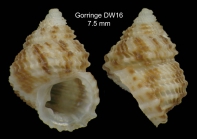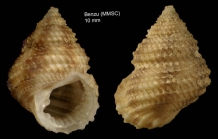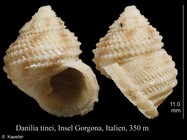WoRMS taxon details
Danilia tinei (Calcara, 1839)
146885 (urn:lsid:marinespecies.org:taxname:146885)
accepted
Species
Monodonta limbata R. A. Philippi, 1844 · unaccepted
Monodonta tinei Calcara, 1839 · unaccepted
Trochus bilabiatus R. A. Philippi, 1852 · unaccepted
Trochus horridus O. G. Costa, 1861 · unaccepted (synonym)
Trochus profugus De Gregorio, 1889 · unaccepted (synonym)
- Variety Danilia tinei var. minor Almera & Bofill y Poch, 1898 † accepted as Mareleptopoma minor (Almera & Bofill y Poch, 1898) † (unaccepted > superseded combination)
marine
(of Monodonta tinei Calcara, 1839) Calcara P. (1839). Alcune nuove specie di conchiglie appartenenti a diversi generi del sig. De Lamarck ritrovate e descritte dal dottor Pietro Calcara. <i>L'Oreteo, Palermo 3-4 [reprint &6 p., 1 pl, stamperia G. Pedone, Palermo]</i>:
page(s): 14-15 [reprint]; pl. fig. 8 [details]
page(s): 14-15 [reprint]; pl. fig. 8 [details]
Note Palermo, Sicily, and island of Pantelleria
From editor or global species database
Type locality Palermo, Sicily, and island of Pantelleria [details]
Distribution Eastern Atlantic, from Norway to Morocco, also on the island of Madeira, generally 100-300 m. Gorringe, Josephine, Seine...
Taxonomy Monterosato (1914) figured the holotype from Calcara's collection and distinguished as separate species the fossil Danilia...
Distribution Eastern Atlantic, from Norway to Morocco, also on the island of Madeira, generally 100-300 m. Gorringe, Josephine, Seine and Ampère seamounts (moderately common from 129 to 335 m)
[details]
[details]
Taxonomy Monterosato (1914) figured the holotype from Calcara's collection and distinguished as separate species the fossil Danilia...
Taxonomy Monterosato (1914) figured the holotype from Calcara's collection and distinguished as separate species the fossil Danilia otaviana (Cantraine, 1835) and the two Recent D. tinei and D. horrida (Costa, 1861) = costellata (Costa, 1861), followed in this by Palazzi & Villari (2001). The fossil species is quite convincingly distinguished by a globose shape and much finer sculpture in which the spiral elements clearly dominate. The holotype of D. tinei is also globose but has a coarse sculpture with nodose cords, whereas the common form (including that on photographs herein) should go to D. costellata if two species are really to be separated. This is a topic that requires further research. [details]
MolluscaBase eds. (2025). MolluscaBase. Danilia tinei (Calcara, 1839). Accessed through: World Register of Marine Species at: https://www.marinespecies.org/aphia.php?p=taxdetails&id=146885 on 2025-04-04
Date
action
by
![]() The webpage text is licensed under a Creative Commons
Attribution 4.0 License
The webpage text is licensed under a Creative Commons
Attribution 4.0 License
Nomenclature
original description
(of Monodonta tinei Calcara, 1839) Calcara P. (1839). Alcune nuove specie di conchiglie appartenenti a diversi generi del sig. De Lamarck ritrovate e descritte dal dottor Pietro Calcara. <i>L'Oreteo, Palermo 3-4 [reprint &6 p., 1 pl, stamperia G. Pedone, Palermo]</i>:
page(s): 14-15 [reprint]; pl. fig. 8 [details]
original description (of Monodonta limbata R. A. Philippi, 1844) Philippi, R. A. (1844). <i>Enumeratio molluscorum Siciliae cum viventium tum in tellure tertiaria fossilium, quae in itinere suo observavit. Vol. 2</i>. Halle [Halis Saxorum]: Eduard Anton. iv + 303 pp., pls 13-28., available online at https://www.biodiversitylibrary.org/page/46936062
page(s): 157, pl. 25 fig. 19 [details]
original description (of Trochus bilabiatus R. A. Philippi, 1852) Philippi, R. A. (1846-1855). Die Kreiselschnecken oder Trochoideen (Gattungen <i>Turbo, Trochus, Solarium, Rotella, Delphinula, Phasianella</i>). In Abbildungen nach der Natur mit Beschreibungen. <em>In: Küster, H. C.; Ed. Systematisches Conchylien Cabinet von Martini und Chemnitz. Zweiten Bandes, dritte Abtheilung.</em> 2(3): 1-372, pl. 1-49. Nürnberg: Bauer & Raspe (pp. 1-24 [1846], 25-32 [1847], 33-72 [1848], 73-120 [1849], 121-136 [1850], 137-232 [1851], 233-248 [1852], 249-372 [1855]; pl. 1-6 [1846], 7-18 [1847], 19-24 [1848], 25-32, 34-39 [1849], 40-45 [1850], 33, 46-49 [1851])., available online at http://www.biodiversitylibrary.org/item/106978 [details]
original description (of Trochus horridus O. G. Costa, 1861) Costa, O. G. (1861). Microdoride mediterranea; o, Descrizione de poco ben conosciuti od affatto ignoti viventi minuti e micoscropici del Meditterraneo, pel professore O. G. Costa. Tomo primo. Con tredici tavole. i-xviii, 1-80. Stamperia dell'Iride, Napoli., available online at http://biodiversitylibrary.org/item/47094 [details]
original description (of Trochus profugus De Gregorio, 1889) De Gregorio, A. (1889). Esame di taluni molluschi viventi e terziari del Bacino Mediterraneo. <em>il Naturalista Siciliano.</em> 8 (10-11): 248-256 [July 1, 1889]; 8 (12):275-292; pl. 4-5 [September 1, 1889]., available online at https://www.biodiversitylibrary.org/page/11572642
page(s): 283, pl. 5 fig. 12 [details]
basis of record Vilvens, C. & Héros, V. (2005). New species and new records of <i>Danilia</i> (Gastropoda: Chilodontidae) from the Western Pacific. <em>Novapex.</em> 6(3): 53-64., available online at http://biodiversitylibrary.org/page/42368139 [details]
page(s): 14-15 [reprint]; pl. fig. 8 [details]
original description (of Monodonta limbata R. A. Philippi, 1844) Philippi, R. A. (1844). <i>Enumeratio molluscorum Siciliae cum viventium tum in tellure tertiaria fossilium, quae in itinere suo observavit. Vol. 2</i>. Halle [Halis Saxorum]: Eduard Anton. iv + 303 pp., pls 13-28., available online at https://www.biodiversitylibrary.org/page/46936062
page(s): 157, pl. 25 fig. 19 [details]
original description (of Trochus bilabiatus R. A. Philippi, 1852) Philippi, R. A. (1846-1855). Die Kreiselschnecken oder Trochoideen (Gattungen <i>Turbo, Trochus, Solarium, Rotella, Delphinula, Phasianella</i>). In Abbildungen nach der Natur mit Beschreibungen. <em>In: Küster, H. C.; Ed. Systematisches Conchylien Cabinet von Martini und Chemnitz. Zweiten Bandes, dritte Abtheilung.</em> 2(3): 1-372, pl. 1-49. Nürnberg: Bauer & Raspe (pp. 1-24 [1846], 25-32 [1847], 33-72 [1848], 73-120 [1849], 121-136 [1850], 137-232 [1851], 233-248 [1852], 249-372 [1855]; pl. 1-6 [1846], 7-18 [1847], 19-24 [1848], 25-32, 34-39 [1849], 40-45 [1850], 33, 46-49 [1851])., available online at http://www.biodiversitylibrary.org/item/106978 [details]
original description (of Trochus horridus O. G. Costa, 1861) Costa, O. G. (1861). Microdoride mediterranea; o, Descrizione de poco ben conosciuti od affatto ignoti viventi minuti e micoscropici del Meditterraneo, pel professore O. G. Costa. Tomo primo. Con tredici tavole. i-xviii, 1-80. Stamperia dell'Iride, Napoli., available online at http://biodiversitylibrary.org/item/47094 [details]
original description (of Trochus profugus De Gregorio, 1889) De Gregorio, A. (1889). Esame di taluni molluschi viventi e terziari del Bacino Mediterraneo. <em>il Naturalista Siciliano.</em> 8 (10-11): 248-256 [July 1, 1889]; 8 (12):275-292; pl. 4-5 [September 1, 1889]., available online at https://www.biodiversitylibrary.org/page/11572642
page(s): 283, pl. 5 fig. 12 [details]
basis of record Vilvens, C. & Héros, V. (2005). New species and new records of <i>Danilia</i> (Gastropoda: Chilodontidae) from the Western Pacific. <em>Novapex.</em> 6(3): 53-64., available online at http://biodiversitylibrary.org/page/42368139 [details]
Other
additional source
Monterosato, T. A. di. (1914). Sur le genre <i>Danilia</i>. <em>Journal de Conchyliologie.</em> 61 (4): 381–384; pl. IX [June 30th, 1914]., available online at https://www.biodiversitylibrary.org/page/16294643 [details]
 Present
Present  Present in aphia/obis/gbif/idigbio
Present in aphia/obis/gbif/idigbio  Inaccurate
Inaccurate  Introduced: alien
Introduced: alien  Containing type locality
Containing type locality
From editor or global species database
Biology Type of larval development: short planktonic, non-planktotrophic as usual in Vetigastropoda and Patellogastropoda [details]Diagnosis Shell up to 10 mm high, with conical spire and rounded body whorl. Sculpture very characteristic with elevated spiral cords, unequal in zize and narrower than interspaces, crossed by thin, prosocline lamellae which form knobs where overriding the cords. Peristome flaring in adult shells, with a distinct outer varix and with internal denticles elongated in the spiral direction. Columella with a strong denticle. Background colour greyish with broad brown flames, inside of aperture nacreous. [details]
Distribution Eastern Atlantic, from Norway to Morocco, also on the island of Madeira, generally 100-300 m. Gorringe, Josephine, Seine and Ampère seamounts (moderately common from 129 to 335 m)
[details]
Taxonomy Monterosato (1914) figured the holotype from Calcara's collection and distinguished as separate species the fossil Danilia otaviana (Cantraine, 1835) and the two Recent D. tinei and D. horrida (Costa, 1861) = costellata (Costa, 1861), followed in this by Palazzi & Villari (2001). The fossil species is quite convincingly distinguished by a globose shape and much finer sculpture in which the spiral elements clearly dominate. The holotype of D. tinei is also globose but has a coarse sculpture with nodose cords, whereas the common form (including that on photographs herein) should go to D. costellata if two species are really to be separated. This is a topic that requires further research. [details]
Type locality Palermo, Sicily, and island of Pantelleria [details]
To Biodiversity Heritage Library (3 publications)
To Malacopics (Danilia tinei (Calcara, 1839) Italy, Lazio, Roma, Secche di Tor Paterno, at 47 m de...
To PESI (from synonym Monodonta tinei Calcara, 1839)
To PESI (from synonym Monodonta limbata R. A. Philippi, 1844)
To PESI (from synonym Trochus bilabiatus R. A. Philippi, 1852)
To PESI (from synonym Trochus horridus O. G. Costa, 1861)
To PESI (from synonym Trochus profugus De Gregorio, 1889)
To PESI
To Malacopics (Danilia tinei (Calcara, 1839) Italy, Lazio, Roma, Secche di Tor Paterno, at 47 m de...
To PESI (from synonym Monodonta tinei Calcara, 1839)
To PESI (from synonym Monodonta limbata R. A. Philippi, 1844)
To PESI (from synonym Trochus bilabiatus R. A. Philippi, 1852)
To PESI (from synonym Trochus horridus O. G. Costa, 1861)
To PESI (from synonym Trochus profugus De Gregorio, 1889)
To PESI



